Biography of John MacWhirter (Victorian painter)
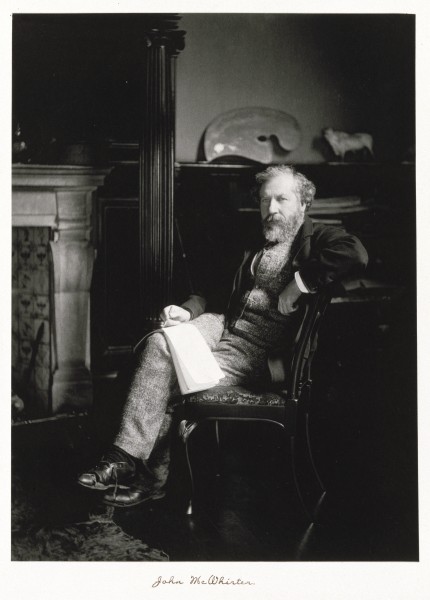 Contents Contents
Overview
Family
Transcription of obituary
While researching the 'McCulloch Collection of Modern
Art', which featured at the Royal Academy Winter Exhibition in 1909, we came
across the name of Scottish painter John MacWhirter (1837 - 1911). Photo
above, source Wikimedia.
McCulloch
purchased three of his large paintings:
A Highland Bay
numbered 3 in the exhibition catalogue, in which it was
described:
View from a rocky and wooded height across the bay,
with mountains beyond; in the middle distance is a tower at the end of a
spit of land, other buildings on the left; numerous fishing vessels. Signed
'MacW'. Canvas 40 x 51 in.
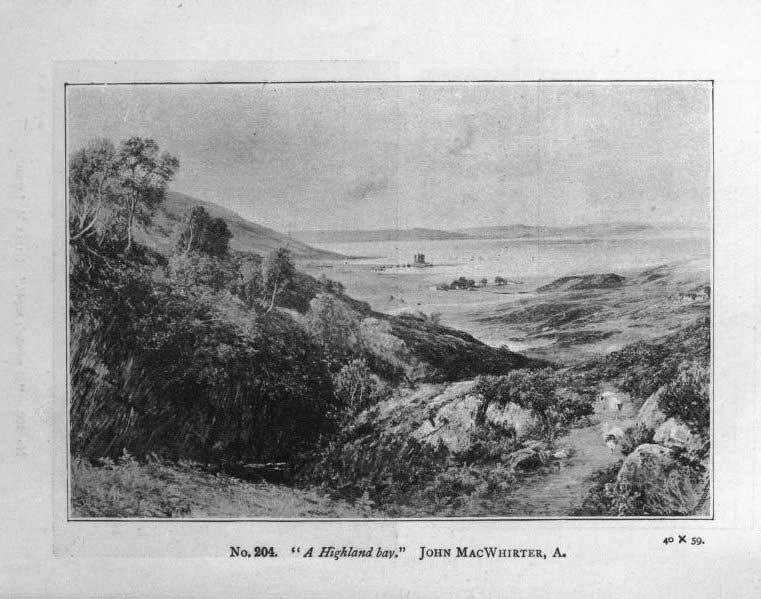
A Highland Bay
from Academy Notes 1891, courtesy of LR
McCallum
(Academy Notes is a journal, like the 'Art Journal' but
coming out after the Royal Exhibition each year with either engravings or
sketches of what they consider the best of the exhibition).
The Sleep That is Among the Lonely Hills
numbered 73 in the exhibition catalogue, in which it was
described:
View looking down a glen, with high rocks on the
right, crowned by Scotch firs; high mountains in the distance; evening
sky. Signed 'MacW'. Canvas 47 x 71 in.
The title above was possibly taken from William
Wordsworth's poem 'Song at the Feast of Brougham Castle' written in 1888.
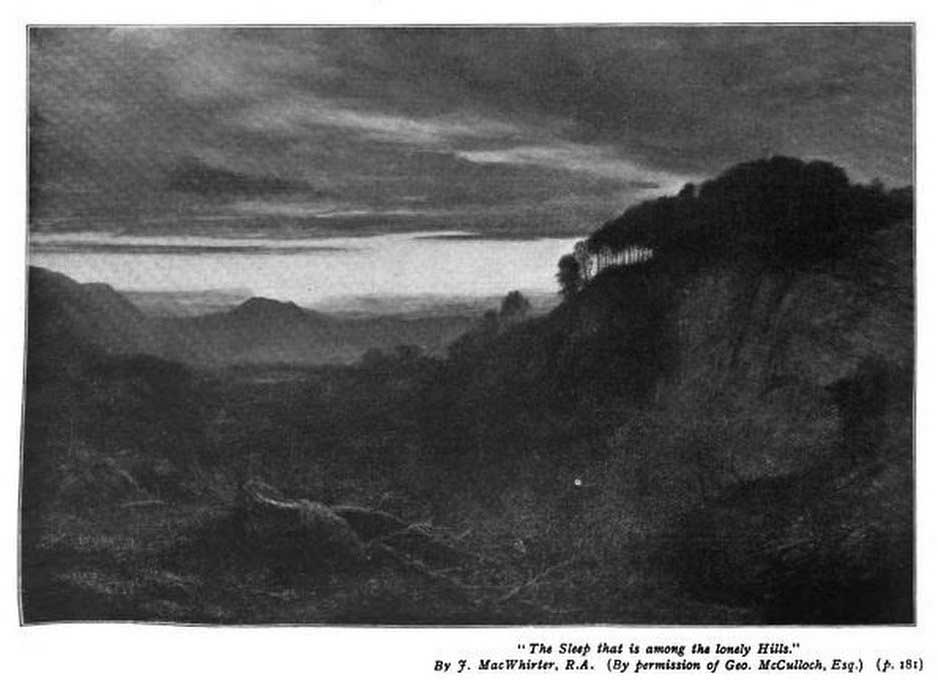
The Sleep that is among the lonely Hills
from the Art Journal 1896, courtesy of LR McCallum
MacWhirter's obituary in an Australian newspaper
describes this as one of his best pictures. That is hard to imagine from
this black and white print, but perhaps the rich colours of sunset add
another dimension.
Karen Howe of La Luna Antiques, Rochelle, Virginia USA
sent us a copy of this reproduction showing how the original painting may
have looked.
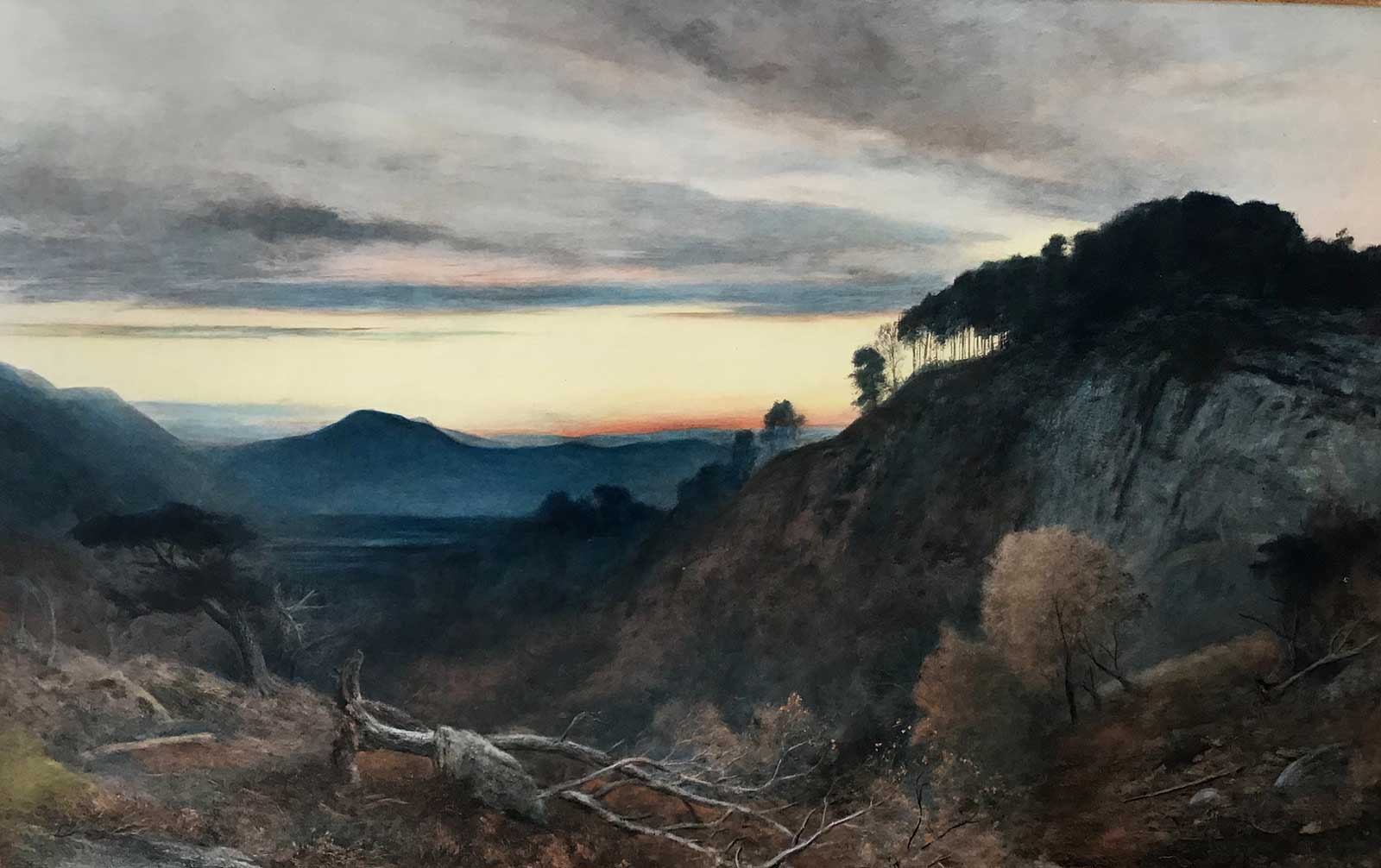
The Sleep that is among the lonely Hills
Credit: Karen Howe, La Luna Antiques,
Instagram
numbered 215 in the exhibition catalogue, in which it was
described:
The river, in spate, and flowing between steep and
rugged banks, occupies the centre of the picture; grey and stormy sky.
Signed 'MacW'. Canvas 47 x 74 in.
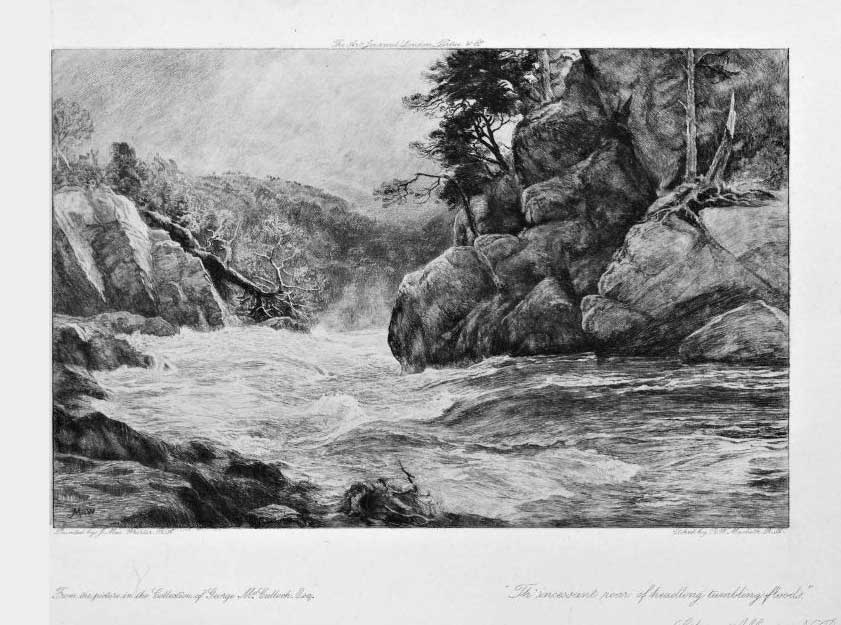
A Spate, Glenn Affaric
from Art Journal 1903, courtesy
of LR McCallum
So who was MacWhirter? His entry in the Dictionary of
Victorian painters summarises him thus:
Scottish landscape painter. Born in Edinburgh.
Elected ARSA 1867, but left Edinburgh soon after to settle in London.
Exhibited at RA 1865 - 1904, New Watercolour Society, Grosvenor Gallery and
elsewhere. Elected ARA 1879, RA 1894. MacWhirter's preference was for
peaceful and poetic landscapes. At first he attempted Pre-Raphaelite detail,
but later abandoned this for a broader style. Travelled widely in Europe and
America, and in the Alps, France and Italy.
You will find him listed in the Oxford Dictionary of
National Biography, and this account simply adds a little more information about his family and
contemporaries.
John was the son of George MacWhirter or McWhirter and
his second wife Agnes Laing. George was a bleached paper maker who took over
Mossy Mill at
Colington
a suburb of Edinburgh in 1838; the family are also said to have had
bleachfields at their other mill at Inglis Green, Slateford.
John's mother Agnes Laing had military connections; she was
the sister of soldier Major
Alexander Gordon Laing,
latterly
a North African explorer, who is thought to have been killed by Arab bandits
near Timbuktu in 1826. John's maternal grandmother was the sister of General Gabriel
Gordon (1762 - 1855) who had been named after his maternal uncle
General
Gabriel Christie. Gabriel Gordon spent 20 years in the West Indies and Canada,
returning to Jamaica in 1803; soon after, he was appointed to command the
British settlement at the Bay of Honduras, being ultimately Deputy
Quartermaster General at that station. He took part in the capture of
Martinique and
Guadalope in 1809.
A
striking portrait of Gabriel Gordon was painted by Scottish artist
Sir John Watson, who for some reason appended Gordon to his surname in
1826.
John's father, George, died in Scotland about 1850, aged 64 years, when John was only 13,
and perhaps it was the family's association with paper production that
stimulated John's interest in art. John's sister, Agnes MacWhirter (1833–1882),
was a still-life painter of considerable repute; her pictures were generally
small and minutely painted.
We think John's younger brother, George, became a merchant seaman,
and his youngest brother, Alexander Gabriel MacWhirter, became a soldier in the Second
Dragoon Guards. Neither married and so it seems to have fallen to John to
become the anchor of the family in later life.
In 1871 John MacWhirter, aged 32 years, was living at
Lichfield Villas, Marylebone. Also in the household were his mother Agnes;
sisters Hugenia and Agnes; an 'aged aunt' Barbara Laing; and a servant. It
would seem there were plenty of women to run his household, allowing him to
concentrate on his work.
In 1872 John MacWhirter married Katherine Cowan Menzies,
the daughter of Allan Menzies (1804 - 1856), a lawyer who had latterly been
Professor of Conveyancing at Edinburgh University.
The 1881 census records the couples' children being
looked after by John's sisters. By 1891 the family had settled at 1 Abbey
Road, St Johns Wood an area popular with artists; John now has 3 servants
and visiting the household was a
niece, Pauline Douglas, who was born in Berlin.
Living at Abbey Road in 1901 were John; his wife
Katherine; daughter Helen; son Alan; sister Hugenia; son in law, the painter
Charles Henry Sims; daughter Agnes; grandson John; and four housemaids.
The 1911 census records that John MacWhirter's house at
Abbey Road had 15 principal rooms. By then John had died and living there were his
widow Katherine; her sister in law Hugenia; son Alan; daughter Helen; son in
law, solicitor Sydney Malcolm Baird; grandson Michael aged 8 months; a
parlourmaid, cook, housemaid and a nurse. One imagines, financially, John
MacWhirter must have been doing quite well.
Number 3 Abbey Road next door to MacWhirter's home
was purchased by a forerunner of EMI circa 1930 and became the
Abbey Road Studios.
Children
John and Katherine MacWhirter had four children:
Agnes Helen (1873 - 1964); Helen Agnes (1875 - 1967);
Ulric George (1878 - 1948); and Alan Gordon (1882 - 1939).
Their eldest daughter Agnes Helen MacWhirter married gifted
painter
Charles Henry Sims (1873 - 1928) and the couple had three children, John,
Alan and Peter.
The art collector George McCulloch had three paintings by
John MacWhirter's son-in-law Charles Sims ARA in his collection:
-
186
The Kite, a girl in a white dress and straw hat gazing at a boy
flying his kite, 27 x 35 in. Now in the National Museum of Wales.
-
308 Drying day, 17 x 21 in
-
309 Washing day, 16x 19 in
Sadly Charles Sims is reported to have become mentally ill
in later life and committed suicide.
De Ruvigny's Roll of Honour records that tragically John MacWhirter's grandson,
naval cadet John Sims, was killed in 1914. The transcription reads:
Sims, John, Naval Cadet, Royal Navy, HMS Bulwark, eldest
son of Charles Sims of Lodsworth, Petworth, ARA, by his wife Agnes Helen,
daughter of the late John MacWhirter RA; born Hammersmith, London, 17th
October 1898; educated The Wells House, Malvern Wells; entered the Navy Sept
1911; appointed to HMS Bulwark 16th August 1914, and was lost when the ship
was blown up off Sheerness 26th November 1914.
It is said the accident may have been caused by the
storage of
cordite too close to the boiler room.
Helen Agnes MacWhirter married solicitor Sydney Malcolm
Baird.
The life of Ulric George MacWhirter is a mystery; we last
found him in 1891 aged 13 years, living with his parents in London - but a
man of that name and of similar age died in Staffordshire in 1948, which
might possibly be him. We wondered if he could have joined the army or gone
abroad?
Alan Gordon MacWhirter, the youngest, became a
professional singer, performing in the UK, and abroad, under the name Alan
MacWhirter. A New York newspaper described him as the 'Scotch Baritone'. In
1920 at Cardiff he married Doris Mary Cooke, the daughter of John Philip
Cooke, who in 1901 had been the proprietor of a Coffee House in
Brighton.
Alan MacWhirter's name appeared in the Radio Times in
relation to a concert which was broadcast on 7th January 1927; that suggests
he may have been
a member of the once famous band of violinist
Corelli Windeatt (1868 - 1947).
An article in the Mercury newspaper said this about
Corelli in relation to Weston Super Mare:
Nor must one forget the brilliant contribution to Grand
Pier and Weston music generally over many years of Corelli Windeatt. He was
a violinist of rare talent who studied at the Royal Academy of Music with
Prosper Stanton (Court violinist to Queen Victoria). Although only in his
teens, he won Royal Academy of Music medals and diplomas and achieved fame
as a solo violinist. He was also engaged for concert tours with famous
artistes. Corelli's father was a Weston music teacher and concert performer.
Affectionately known as 'Old Boy Windeatt', he was rarely seen without his
fiddle box. He taught at the Weston College and other schools and founded
and conducted the Weston Orchestral Society. Sometimes at local concerts
there were as many as seven members of his clever family in the orchestra. A
breakdown in the health of his father brought Corelli back to Weston to
carry on his teaching connections. He also had his own orchestra, which he
conducted for seasons at both piers and at many events in the district,
including the balls arranged by Squire Smyth Pigott at his Brockley manorial
residence. Eventually Corelli returned to London and formed a dance band that
became famous the country over and was in great demand for society balls and
garden parties. It was featured at the Chelsea Arts Ball at the Albert Hall
and at fashionable polo gatherings at Ranelagh.
A painting of Alan MacWhirter by his brother in law
Charles Sims is said to be held by the Royal Cornwall Museum in Truro.
Baritone, Alan Gordon MacWhirter died in 1939. His father, the painter
John MacWhirter, had died in 1911 and a transcription of John's obituary appears
below.
Source: The Times Monday January 30th 1911
OBITUARY
Mr John MacWhirter RA
Mr John MacWhirter RA died at his house in Abbey Road, St
John's Wood, on Saturday, of bronchitis, from which he had been suffering
for about six weeks.
In spite of his illness he continued to work in his
studio until a week ago because he was anxious to finish four pictures for
this year's Academy.
John MacWhirter was the son of the late George
MacWhirter, paper manufacturer, of Colington, Edinburgh and was born at
Slateford, near Edinburgh on March 27th 1838.
He came of an old Ayrshire family, one of whom was
numbered among the 'Ayrshire Martyrs'. He was 13 when his father died, an
event which caused him to leave school at Peebles and to enter as an
apprentice into the business of Oliver and Boyd, the booksellers and
publishers. But already the love of art was strong in him, and after six
months he broke his articles, determined to become a painter.
When he was 14 he exhibited his first work at the Royal
Scottish Academy, and about the same time entered the Arts Schools, then
under the direction of an excellent painter,
Robert Scott Lauder RSA.
It was a good moment in the Edinburgh schools, and among
MacWhirter's companions were a number of men who soon attained distinction –
William MacTaggart, Hugh Cameron, and three painters who were afterwards his
close friends and colleagues in the Royal Academy,
John Pettie, Peter Graham
and
WQ Orchardson. Under Lauder's training MacWhirter made rapid progress;
his love of nature was keen and his industry great, so that each year's
exhibition saw him steadily advancing.
From the years 1856 onwards he seldom exhibited fewer
than five pictures, and in 1867, when he was 28, he was elected ARSA. His
studies were made in the Highlands, where he spent a large part every year,
and on the Continent, where he had travelled constantly since he was a boy
of 16.
His first Academy picture, a 'Temple of Vesta' was shown
in 1856, and from 1870 he exhibited in London – generally two landscapes
each year – without a break. In 1879 he was elected ARA and in 1893 full
Academician, in the company with Mr
Henry Woods and the late
Henry Moore.
Before and after that time his style and subjects varied
little; the large majority of his pictures and drawings have been views of
the Highlands, with blue, sunlit lakes, and commonly a group of Scotch firs
or graceful birch trees in the foreground. Sometimes, however, he has given
us Italian lake scenes or Swiss meadows starred with flowers, such as the
well-known 'Alpine Meadow' or that 'June in the Austrian Tyrol' which was
bought in 1892 out of the
Chantrey Fund.
His Ideals and Methods
In 1900 Mr MacWhirter published a book 'Hints to Students
on Landscape Painting in Water-Colour' and this is a useful commentary upon
his own ideals and methods. He begins with advising the pupil 'always to
carry a notebook', and this was his invariable rule. 'You cannot train your
memory too soon. . . . Take rapid notes of all sort of things. . . . You
should sit down for days (or weeks if you like) before a tree or a root of a
tree, and get all the detail and beauty you can into your drawing. Paint
also ferns, mosses, bits of stick, smooth and rough stones, rocks etc. Study
flowers especially. . . . If you continue filling your note-books with
studies such as I have indicated, as well as with studies of clouds,
mountains etc you will be able with the knowledge thus acquired to paint a
distinct impression of a scene which has passed away'.
This is excellent advice, and MacWhirter's own sketches
prove that it was followed by himself. Indeed, though his finished pictures
remained to the end popular with the many, artists and skilled amateurs came
to admire them less than his sketches and studies.
They were much too composed; they tended to repeat a
limited number of motives a little too obviously; and their colour was a
little chalky and cold. MacWhirter knew that this was the opinion held about
his works in 'modern' circles and being a good fighter would argue against
modern heresies with force and with racy Dorian energy.
He was intensely Scotch, but the 'Glasgow School' of
today did not command much of his sympathy. None the less, he was much liked
and respected by his colleagues and by the art-world generally.
Mr MacWhirter married in 1872 the daughter of Professor
Menzies, of Edinburgh. One of his daughters – of whom Sir L
Alma Tadema once
painted a charming small portrait – is married to Mr Charles Sims, on of the
best of our younger painters.
The funeral will take place at the Golder's Green
crematorium on Wednesday at 12 o'clock.
The National Probate Calendar records that painter John
MacWhirter of 1 Abbey Road, St Johns Wood, Middlesex, died on 28th January
1911. His executors were Katherine MacWhirter, widow; Charles Edward
Johnson, artist; and Sydney Malcolm Bird, solicitor, his son in law. He left
effects of £29,983.
Landscape painter Charles Edward Johnson (1837 - 1913)
was a contemporary of John MacWhirter; he had begun his career as an artist
in Edinburgh moving to London in 1864. In 1891, when he was living in
Hampstead, he was a neighbour of British painter and sculptor Sir
James Dromgole Linton, and of the American painter and sculptor
George Faulkner Weatherbee (1851 - 1920) who was born in Cincinnati,
Ohio. In later life Johnson conducted a school for landscape painting at
Richmond; he died not long after John MacWhirter in 1913.
The reference to John MacWhirter coming from an old
Ayrshire family, one of whom was numbered among the 'Ayrshire Martyrs',
probably relates to a religious dispute between
Covenanters
who believed there was no place for a hierarchical organisation within the
Scottish church, such as bishops, and the English establishment; this went on for many years.
In 1679 a battle took place at Bothwell Bridge on the
Clyde between a group of Covenanters and troops of Charles II. About 210 of the
participants, who were declared traitors and sentenced to be banished to work
as slaves on American plantations, were drowned when the
Crown of London was shipwrecked off the Orkneys. One of those men was a
John McWhirter, whose name appears on the
Covenanter's Memorial at Maybole, south of Ayr.
If you can add to this account do please get in touch.
Back to top
References
- The Times Digital Archive
- Census of England and Wales
- National Probate Calendar
- Wikipedia
- Dictionary of Victorian Painters
- Oxford DNB
- McCallum,
Lawrence, George McCulloch GLASGOW, BROKEN HILL & KENSINGTON, A life of
Ships, Sheep, Silver and Art, ISBN 9780473310530, published 2015.
- Communication from LR McCallum, May 2017
- Communication from Karen Howe, October 2019
|

